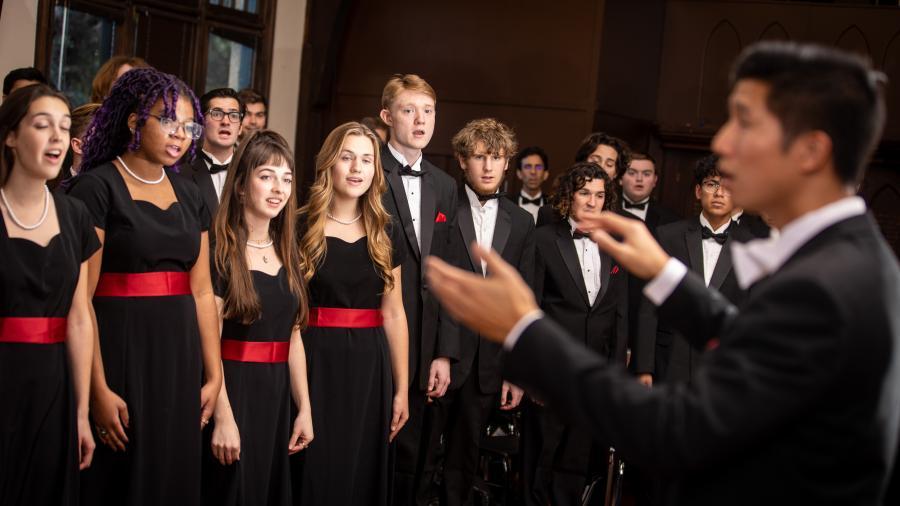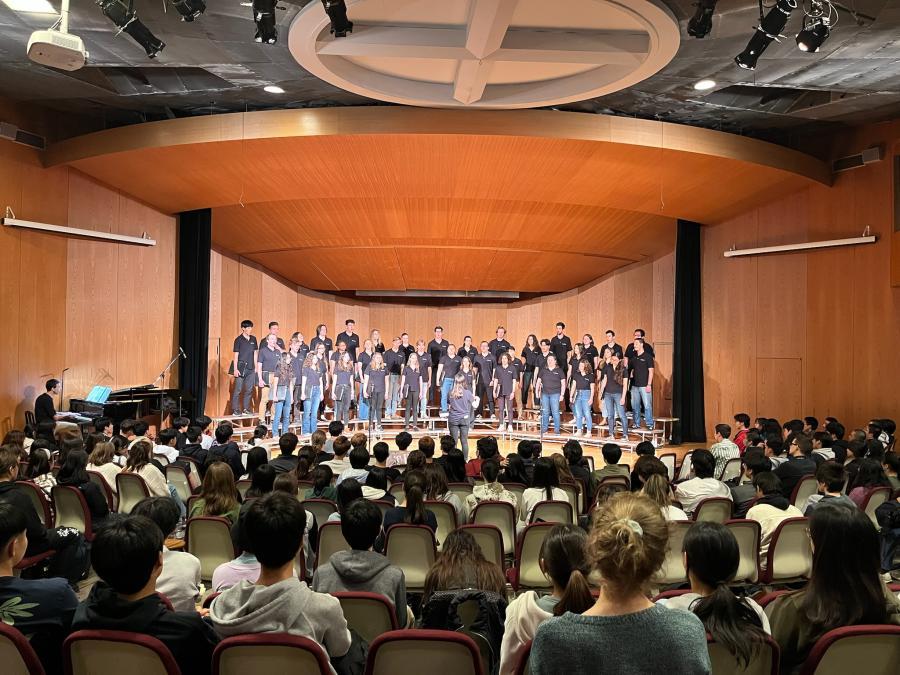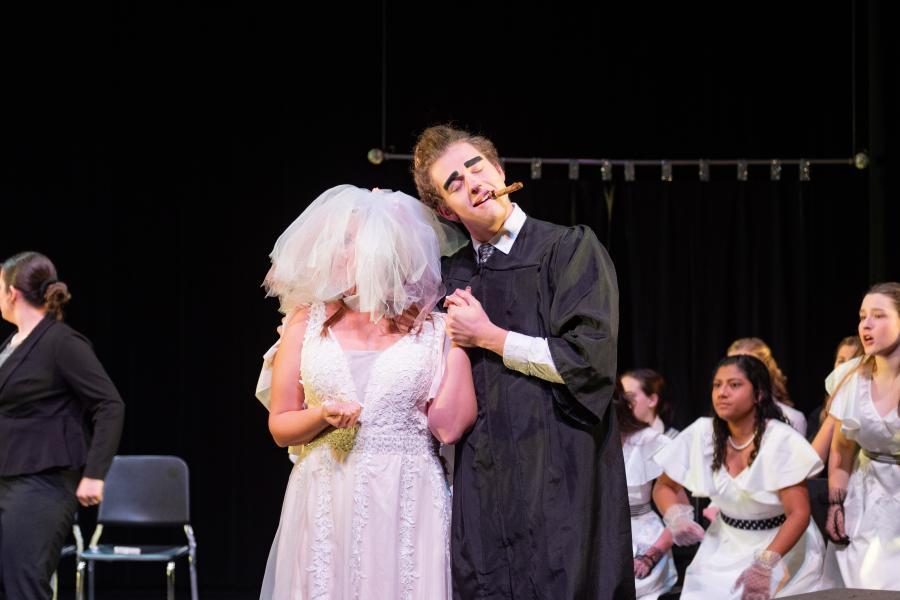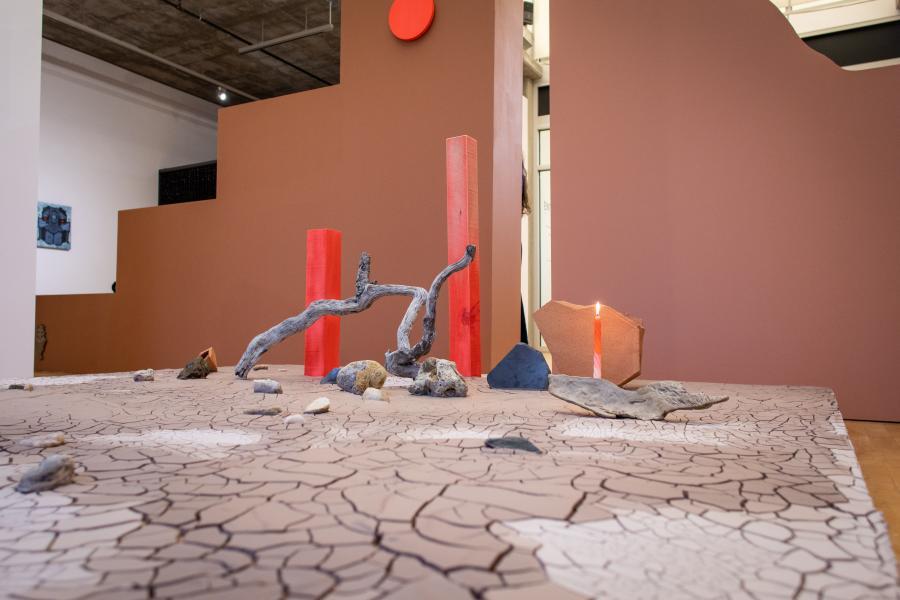Westmont Magazine Music and the Museum Thrive and Inspire

by Kelly Vivanco ’24
College Choir Travels to Tokyo for an International Tour
Following Commencement 2023, the Westmont College Choir and Chamber Singers embark on a nine-day tour to Tokyo, Japan — the first international choir tour since the COVID-19 pandemic. Led by Daniel Gee ’13, assistant professor of music and director of choral activities, the choirs’ itinerary includes joint concerts with Japanese collegiate ensembles, including those from Waseda University and the Tokyo College of Music, as well as performances at Tokyo Union Church, Tokyo Christian University and the Christian Academy of Japan.
As part of its tour repertoire, the choir will perform pieces by Japanese composers such as Ko Matsushita, Maki Ueda and Takatomi Nobunaga, as well as what Gee describes as “a multifaceted representation of American choral music.” This mix of pieces ranges from Western Classical, the Black American spiritual and gospel tradition, and Latin American traditions.
Many of this year’s seniors on the tour experienced their first year in College Choir in 2020-21, when Gee joined the faculty. It was a challenging start to his time at Westmont due to COVID-19 restrictions. These students first rehearsed with him by Zoom, making this year’s international tour together an especially meaningful way to conclude their choral experience at Westmont.
Thanks to experienced tour management by music department staff Keith Erickson ’12 and Mandy Kellogg ’15, the students will see historical, cultural and natural sights such as Mt. Fuji as they travel in Japan and perform. Gee emphasized the tour’s main purpose: “It’s building relationships with Japanese students and singers,” he says. “That’s why you go.”
On his first international tour since becoming choir director, Gee says he looks forward to connecting with musicians and Christians in Japan as well as to introducing many Westmont students to this part of Asia for the first time. He also anticipates seeing the ensemble’s friendships grow even stronger.
“I feel a kinship with the students as we get to share music together,” he said. “It will be a fun culmination of that.”
Opera Offers Double Bill of Humor
In early January, music students and faculty returned from winter break for an opera boot camp on campus, committing to an ambitious double bill of Gilbert and Sullivan’s “Trial by Jury” and Rossini’s “The Silken Ladder.” Two sold-out crowds (January 27 and 29) at Center Stage Theater in downtown Santa Barbara rewarded their efforts.
“They should be proud of all they accomplished,” says Ruth Lin, music department chair and conductor of the Westmont Orchestra. “It’s very uncommon for a school of this size to do full productions of operas, especially on such a short timeline. They were willing to put themselves out there and stretch and bend and try things they would never have dreamt of previously. This was a valuable musical experience — no doubt they each learned a great deal about their own music-making process, grew as musicians and humans, and gained valuable insights into how an opera comes together.”
The production, set on a large movie studio in the 1930s, featured a black-and-white moving picture (“Trial by Jury”) and then a full-color feature film (“The Silken Ladder”). “The idea was that a company films a double feature, spanning the gap between black-and-white moving pictures and Technicolor movies,” says Christina Farris Jensen ’09, stage director. “Each show was set in its own time with ‘Trial by Jury’ in Victorian England and ‘The Silken Ladder’ in the early-mid 1800s. The stark visual difference between the two shows was exciting.”
The cast featured tenor Sibongakonkhe (Sibo) Msibi, a senior international student from Swaziland, who earned a fellowship to the Music Academy of the West’s 75th anniversary Summer School and Festival in 2022. Other cast members include Joy Sturges, Katie Ticas, Caleb Wilcox, Sean Ryan, Nathan Carlin, Micah Howard, Chandler Baker, Rachael Todd, Melissa Ellsworth, Alyssa Burdick, Jordyn Clinton, Erin Hardin, Jessica Berman, Sequoyah Scales, Leighton Bell and Phoebe Tilburt.
Exhibitions Explore Environment
The Westmont Ridley-Tree Museum of Art featured two artists whose work explores climate change and our planet in “Entangled: Responding to Environmental Crisis.” The exhibition highlighted the artwork of Madeleine Tonzi, a New Mexico painter, muralist and printmaker, and GATS (Graffiti Against the System), a well-known Bay Area artist who draws on the urban environment as a source of inspiration.
Tonzi’s largest piece in the exhibition, “Artifacts and Altars,” features a drying bed of mud topped with branches and rocks. “Her work examines how architecture integrates and interacts with the landscape, exploring the context between the human-built environment and the natural beauty of the land,” says Judy Larson, R. Anthony Askew professor of art history and director of the museum.
GATS, an anonymous street artist, used a corner of the gallery to create a hidden place — a sewer or under a bridge — where you would most likely encounter their art. “The manhole cover encourages viewers to focus on the eyes of their iconic and dramatic mask figure,” Larson says.
“Street art and graffiti are non-traditional media for many urban artists, who respond with directness and vigor to the world around us,” says collections manager Chris Rupp. “I believe that’s the greatest strength of street art — its unmediated directness. GATS is a master of communicating to the masses without the written word.
“The current environmental crisis is something that affects all of us. Street art, like murals and graffiti, offer everyone access to the art world. Art becomes part of our everyday lives.”
In conjunction with the exhibition, G. James Daichendt, art critic and professor of art history at Point Loma Nazarene University, spoke about “Street Art Now” on February 23 in the Adams Center for the Visual Arts.
Barry Berkus Collection
Earlier, the museum shared the deep trove of art collected by the late Barry Berkus, an architect, urban planner, watercolor artist and author, in “A Bold and Unconventional Collector: Highlights from the Barry Berkus Family Collection.” He established two design firms, B3 Architects and Berkus Design Studio, with offices in San Francisco, New York, Chicago, Washington, D.C., Atlanta, Miami, Tokyo and Kuala Lumpur.
Berkus loved art — especially the art of his time. “He favored art that was experimental — art that explored unusual ideas,” says Jeffrey Berkus, Barry’s son and also an architect. “He was a bold and unconventional art collector.”
The exhibition highlighted selections from a major gift to the museum from the Berkus Family Collection, plus purchases made from the collection and noteworthy pieces that remain in it.
The museum hosted a panel discussion December 6 with Jeffrey Berkus, Dane Goodman and Ginny Brush, who were all close friends of Barry. They shared personal anecdotes of their time with him, his family and his art collection.




